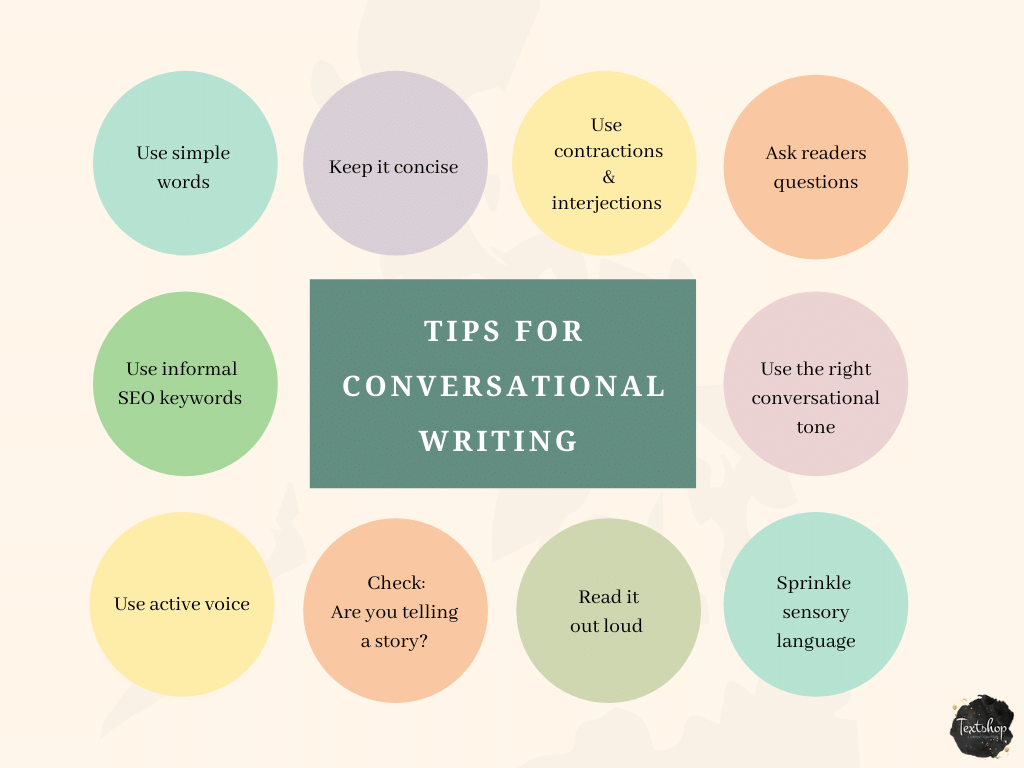How many times have you opened a marketing email or started to read a blog post and glazed over?
Dense, over-complicated writing is a turn-off. And when you have to wade through it for work, what do you do? Yawn? Run? Put it aside for later?
Dreary, tepid content that reads like it was written by a robot will damage the longevity of your brand.
On the other hand, you could deliver bright, warm, on-brand content that makes your readers want to hang around and schmooze.
Let me show you how!
Conversational writing is a unique style of writing that breaks those grammar rules you learnt at high school. Sentences might commence with ‘And’ or ‘But’ and you’ll collide midway through a paragraph with ‘ouch’ or ‘drat’.
It’s fun and friendly. It’s also powerful. You can use conversational writing to connect with people on a deeply personal level.
Dry or overly complicated content is a one-way ticket to be scrolled past and forgotten forever. But smooth effortless-to-read writing will keep your readers reading.
Conversational writing is the way of the future for marketing materials such as email, newsletters, websites and blogs. This is the type of content businesses are using to generate leads and create loyal customers.

The point is to make every single person feel like you’re giving them special attention so they keep coming back. You want your readers to feel like you know them – and, if you’ve researched your niche brand, you do know them.
Plus, if you’re generating well-researched, informative content, they’re likely to share it with others.
One of the best parts of conversational writing is that once you get the hang of it, it can be a really easy style to generate original content every time. It is, however, difficult to master at first. You’ve got to shake the thought of your high school teachers drilling into you that you need to write like the next great novelist.
It can be easy to presume a conversational writing style would be as easy as typing how you’d text your friends.
That is NOT what we’re going for. Developing a conversational tone in your writing means creating simple, easy-to-understand content.

If you were to write the way you speak, though, it could be confusing for readers who don’t know you.
The idea is to create a style of writing that makes the reader feel like you’re addressing them directly. Think of it as getting a virtual cup of coffee with them, not addressing a crowd at a sold-out concert.
Another thing to note is that a conversational writing style is not a one-size-fits-all.
There’s a time and a place.
For example, you wouldn’t put liver puns in an article about fatty liver disease. But you would put puns in a newsletter about cat sweaters. This is why conversational writing is such a valuable skill to have.
If you’re ready to develop your own conversational writing style, follow these tips and experiment and practise until you feel ready to share your work.

Conversational writing should be simple. There’s no need to whip out your thesaurus and find unique words for your content. It’s not that you’re ‘dumbing down’ the writing – you’re making it palatable for every reader.
If you’re writing about a complex topic, such as software, think about the readers. They are likely not going to be experts on the subject, which is why they’ve come to you for answers.
Using data to back up your facts is important, but simplify the wording for everyone to be able to understand. Adding graphs, tables and illustrations to support your writing on more complex concepts is always a good idea.
Here’s an example. Let’s say you’re writing about microgreens and you find this definition:
Microgreens are vegetable greens harvested just after the cotyledon leaves have developed.
You could rewrite this conversationally as:
Microgreens are the young seedlings of vegetables and herbs.
It may not look like much of a difference, but the reader will likely not know what a cotyledon is. You may go on to explain it later, but this is a good place to start to simplify the wording.
Employ user-friendly words and keep sentences and paragraphs short. Nobody hopped online to read lengthy paragraphs to get to the bottom of why their left foot is itchy. Here are two rules to keep in mind:
1. Sentences should be a maximum of 28 words long.
2. Paragraphs should be a maximum of 90 words.
When you look at the numbers, 51% of low-scoring texts have paragraphs that are way too long. The second that readers see a solid block of text, they’ve likely decided to move on. While you’re writing, you can check your word counts to make sure you’re staying in your lane. If you’re having trouble being too wordy, practise writing sentences and removing unnecessary words. This paragraph is about 75 words long; getting bored yet? They should be shorter.
As for sentences, chop ‘em up! Forget what you learned about proper sentence structure in high school. Keep. It. Simple!
Another great way to work on your conversational writing style is to use contractions. So write isn’t instead of ‘is not’ and didn’t instead of ‘did not’.
This makes writing sound more casual as if you’re talking directly to your readers.
When you start using contractions in your writing, you’ll see how it it relaxes the conversational tone.

Interjections are part of natural speech (oops, yikes, bravo) and they’re used to convey emotion and breathe a sense of humanness into writing. Used well they can elevate writing and add interest, but take care to use them sparingly to avoid overkill.
One of the best ways to engage your reader is to ask them questions.
When you’re reading something and the writer asks you a question, it makes you think doesn’t it?
A question is a great way to get your readers to engage and remember the information from your content.
It’s also an excellent way to get engagement on social media platforms such as Facebook, Instagram and Twitter.
When creating a conversational writing style, you should develop your own conversational pitch. That’s part of the fun! It’s also going to make your content memorable and stand out among competitors. It will, of course, depend on your circumstances, but being able to add in tidbits about your personal experience can create a lively connection with your audience.
If your business needs to appeal to more than one type of client, you may need to wear multiple hats when it comes to tone. But persevere because working out the conversational pitch that a particular group of clients is most comfortable with is a must-do task.
While creating your personality in conversational writing, don’t be afraid to add in some pizazz. You can throw in interjections like yay! or ouch! to make your content come alive. Feel free to also get WILD and start sentences with those conjunctions and and but that we discussed earlier. You won’t get an F on your English paper for that here.
–
Sensory language uses words related to our five senses to add emotion to writing. While sensory words may not sound like a good fit for business writing, the payoffs can be huge.
Decades ago, American Nobel Laureate Scientist Herbet Simon observed that “In order to have anything like a complete theory of rationality, we have to understand what role emotion plays in it.” The role of emotion in business decision-making remains a much-discussed topic today.
The Harvard Business Review, for example, has been publishing articles on emotional intelligence for years. And while there’s no formula yet that determines how human decision-making happens, we can garner enough from the science to know that sensory language will influence the way people feel about your products or services.
Now that we’ve got the science out of the way, let’s look at the categories of sensory language we can use to influence customers and generate leads.
We can use visual, tactile and auditory words, as well as words that describe taste and smell. We can also put words that depict motion to good use. Sensory words shouldn’t be over-sprinkled, however. Use them strategically for the greatest impact.
Dazzling, shiny, bright, sparkly, sparkling, tight, gloomy, grin-worthy, glint, glimmer, glow, shine, glossy, vibrant, glitter, knotty, murky, polished, wildly, animated, bulky, delicate, frail, wrinkled, grassy, gloomy, feeble, beefy, crinkled
Razor-sharp, tight, smouldering, faded, hollow, knife-like, watery, tangle, briny, damp, oily, squelch, slimy, fluffy, rough, smooth, hairy, sticky, chilled, gritty, velvety, soft, creamy, rounded, lukewarm, spiky, boiling, tender, sizzling, tepid
Thundering, softly, gently, thumping, crashing, tingling, squeaky, piercing, whoosh, squeal, clump, boom, sploosh, crunchy, ear-splitting, roaring, faint, muted, buzz, whine, unspoken, tinkle, deafening, gurgle, squawk, hum, crackle
Salty, sweet, bitter, sour, spicy, super-spicy, juicy, cucumber cool, crisp, stinky, bite-sized, piece of cake, garden fresh, freshly baked, overpowering, biting, tangy, lemony, minty, sharp, zesty, gooey, deliciously, wildly, intense, fruity, pungent
Pungent, bitter, perfumed, scented, aroma, aromatic, sniff, odour, billowy, biting, faint, wispy, rich, misty, fishy, lemony, tangy, tart, citrusy, earthy, smoky, pine, flowery, lilac, mouldy, musty, rancid, stagnant, stench, gaseous, sharp, briny
Stirring, dart, progress, flow, rapid, gradual, steady, slowly, gradual, slight, sudden, stubbornly, vibrating, mind-boggling, bumpy, stamp out, twirl, swirl, whirl, wriggle, soaring, paralysed, eye-popping, motionless, fleeting, zipping
–
Sensory words are power words!
They engage your reader on deep levels and create a strong emotional connection. Take this example from chocolate maker Green & Black. Sensory words such as crunchy and soft don’t refer to taste, but to touch and sound. Now that’s powerful!
A creative way to include sensory language in your writing is to insert it into metaphors. This can be evocative and moving, but must be used sparingly to have real impact.
Metaphors compare two things that are different to suggest an image, likeness or analogy between them.
Simple examples of business metaphors are:
Taking it to a new level and Growing a business.
Literary metaphors can have an emotional impact on readers, such as:
‘My thoughts are stars I cannot fathom into constellations.’ – John Green, Fault in our Stars.
‘Art washes away from the soul the dust of everyday life.’ – Pablo Picasso
If you’re interested in using metaphors in your conversational writing, be original and quirky. They have much greater impact when they haven’t been read before.
Try to use active voice in conversational writing whenever you can. So, instead of writing ‘The house was sold by the real estate agent,’ write ‘The real estate agent sold the house.’
In active voice, the subject of the sentence performs the action on the action’s target. The passive voice is usually clunky and indirect. Avoid using passive constructions and enliven your sentences with active voice. It’s bright, lively and more direct.
Active voice also enlightens your conversational pitch.
Google prefers active voice and, if you’re looking to rank, and it’s more aligned with the way people speak. If you’re new at writing in an active voice, just practise until it feels natural.
When researching keywords to optimise content for search engines, we analyse ‘reader intent’. So we put ourselves into readers’ shoes and try to predict what they’re going to type into the search engine.
This is great news for conversational writers because the best ranking keywords are often informal, casual and even slang. People favour a conversational voice when they type queries into Google.
As I write this (and remember SEO is constantly evolving) 900 people each month are typing the longtail keyword ‘How to do SEO,’ into Google. But only 10 of them are typing in ‘How to understand SEO.’ It tells us everything, doesn’t it? Conversational language is how readers actually think, themselves.
We use stories to understand and find meaning throughout our lives. If the story isn’t complete, we often ponder the ending in our heads.
There are tremendous benefits in having a story to tell in business writing. Prospective clients are known to make decisions based on the emotional impact they’re experiencing while listening to, or reading, a story.
Cassie Gillette, writing for Semrush’s 2022 Global Report, predicts that storytelling in content marketing will be key in 2022–23. ‘If you’re going to work on one skill this year,’ she wrote, ‘work on being a better storyteller’.
You can use a storytelling structure for any type of business writing, providing the format works with the three components that make a good story – characters, conflict and resolution.
Hubspot discusses how to elevate your brand and connect with your audience through storytelling in this free download.
Wondering if your writing actually sounds conversational, or if you’ve got the tone right?
Have an open mic for yourself and read it out loud!
Try reading your content aloud and recording it. Listen to see if it has a conversational flow to it, and if you enjoy hearing it. Another tip for reading out loud is to see where you pause to take a breath.
A good rule of thumb is that if there is a pause, you should break it into two sentences. This is going to do wonders if you struggle with being super-wordy when you write.
To sum up, conversational writing is a necessary skill if you want to break through the tsunami of mediocre content on the internet.
It’s a powerful tool in marketing that will help you stand out among competitors.
People want personality to shine through when they’re reading content online. They appreciate shiny original text that hasn’t been seen a zillion times before. Sensory language will also add pizzazz, but don’t overdo it.
Warm, human words they trust because you know them already, as well as what they’re looking for. Be a creative conversational writer, an original thinker with a warm-hearted tone and aim to both educate and entertain your audience.
Want to put some punch in your writing? Check out How to make your writing stronger.
Looking to improve your content marketing writing? You’ll enjoy How to be a good content writer.
For tips on writing awesome blog posts, see How to write a smashing blog post.
Sharon is a content writer and award-winning editor. After acquiring two masters degrees (one in education and one in editing and comms) she worked in the publishing industry for more than 12 years. A number of major publishing accomplishments came her way, including the eighth edition of Cookery the Australian Way (more than a million copies sold across its eight editions), before she moved into corporate publishing.
Sharon worked in senior roles in medical colleges and educational organisations until 2017. Then she left her role as editorial services manager for the corporate arm of a university and founded Textshop Content – a content writing and copyediting agency that provides services to Australia’s leading universities and companies.
